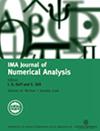Westervelt方程的组合DG-CG有限元法
IF 2.4
2区 数学
Q1 MATHEMATICS, APPLIED
引用次数: 0
摘要
本文提出并分析了二阶超声Westervelt拟线性模型的时空有限元方法。该方法将符合有限元空间离散与不连续伽辽金时间步进相结合。它的分析受到这样一个事实的挑战,即标准的伽辽金测试方法不允许在任何时候对离散能量进行边界。通过重新设计线性化问题的能量参数,结合Banach的不动点参数,我们证明了该方案的适定性,先验误差估计,以及关于强阻尼参数$\delta $的鲁棒性。并且,该方案保持了连续问题的渐近保持性质;更准确地说,我们证明了$\delta>;在奇异消散极限下,0$收敛于离散无粘问题的解。我们使用$(2 + 1)$维度的数值实验来验证我们的理论结果。本文章由计算机程序翻译,如有差异,请以英文原文为准。
Combined DG–CG finite element method for the Westervelt equation
We propose and analyze a space–time finite element method for Westervelt’s quasilinear model of ultrasound waves in its second-order formulation. The method combines conforming finite element spatial discretizations with a discontinuous–continuous Galerkin time stepping. Its analysis is challenged by the fact that standard Galerkin testing approaches for wave problems do not allow for bounding the discrete energy at all times. By means of redesigned energy arguments for a linearized problem combined with Banach’s fixed-point argument, we show the well-posedness of the scheme, a priori error estimates, and robustness with respect to the strong damping parameter $\delta $. Moreover, the scheme preserves the asymptotic preserving property of the continuous problem; more precisely, we prove that the discrete solutions corresponding to $\delta>0$ converge, in the singular vanishing dissipation limit, to the solution of the discrete inviscid problem. We use several numerical experiments in $(2 + 1)$ dimensions to validate our theoretical results.
求助全文
通过发布文献求助,成功后即可免费获取论文全文。
去求助
来源期刊
CiteScore
5.30
自引率
4.80%
发文量
79
审稿时长
6-12 weeks
期刊介绍:
The IMA Journal of Numerical Analysis (IMAJNA) publishes original contributions to all fields of numerical analysis; articles will be accepted which treat the theory, development or use of practical algorithms and interactions between these aspects. Occasional survey articles are also published.

 求助内容:
求助内容: 应助结果提醒方式:
应助结果提醒方式:


